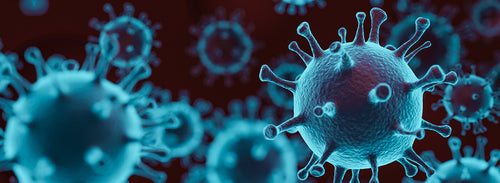The Difference Between Sanitation and Disinfection
Published on December 29, 2020 by Arielle Holland

Blog Updated Nov 9, 2023
Cleaning, Sanitizing, and Disinfecting: Oh My!
Knowing the difference between these three terms can be challenging because they are used interchangeably when discussing cleaners or cleaning solutions. However, each word does have a distinct and differing definition. Recognizing the differences and when to do each could be critical in keeping your family safe and healthy.
“Clean as a Whistle” Might Still Leave You in A Pickle
Although cleaning is an excellent way of staying organized and will get dust and grime away, more is needed to keep bacteria and microorganisms from infiltrating your home. Cleaning is a bland turn for removing something unwanted; cleaning usually refers to removing visible debris or dirt. If you want to give your space a deeper clean, you must resort to more substantial equipment than just a broom, dustpan, and feather duster.
Please Be Wise and Remember to Sanitize
Sanitizing is making a surface sanitary or free of visible dirt contaminants that could affect your health. Much like cleaning, to sanitize an area, you are, in essence, also cleaning, but it also goes the extra step to disinfect from harmful contagions lingering on the surface.
The difference between cleaning and sanitizing is the difference between wiping off a countertop with a paper towel and wiping off the same countertop with a paper towel after spraying the surface with a sanitizing spray. While the first one took off any dirt or debris that might have been on the countertop, it did nothing to prevent or reduce the number of bacteria on the surface.
It is imperative to note that although sanitizer effectively reduces the growth and occurrence of bacteria, viruses, or fungi, it will not kill the microorganisms on that surface. You need to use a disinfectant to efficiently destroy the germs for a fresher and deeper clean.
Protect While You Disinfect
When you want to kill germs on the spot, you need to turn to a disinfectant. Disinfectants contain chemicals that can pack a powerhouse punch when used effectively. Disinfectants need to remain on the surface being cleaned for a short time, usually a few minutes, to completely annihilate the bacterium.
Disinfecting is the best defense in preventing the spread of viruses and infections in homes, schools, and businesses. However, not all disinfectants are made equal. Some disinfectants undergo rigorous testing to be approved by the EPA for killing bacteria and viruses. Disinfectants are the EPA’s only authorized way to ensure that you are killing viruses on hard surfaces. Sanitizing products do not go through these stringent regulations, so if you find a product that is not EPA-registered as a disinfectant but still claims to kill viruses like COVID-19, that is false advertising, and that product should not be trusted.
Remember that disinfectants are highly effective at killing germs when used correctly, but they will not remove them. They will die, but their physical presence will still remain. For that reason, disinfectants and cleaners are often used hand in hand.
Which comes first: Sanitizing or Disinfecting?
It is essential that before sanitizing or disinfecting, you must first start with a clean slate. Make sure that where you attempt to sterilize is cleared of debris, dirt, and dust. After establishing a clean area, it is recommended by the CDC to disinfect it with an “N List Disinfectant.”
Disinfecting will kill the bacteria from the infected surface. Following up with a sanitizer will provide a more thorough cleaning. It will remove those dead bacteria from the area, but it is not required to ensure a protected cleanse.
For more information on recommended cleaning procedures and the advised cleaning supplies, please visit the CDC website at https://www.cdc.gov/poxvirus/mpox/if-sick/cleaning-disinfecting.html.
When to disinfect:
It is believed that Covid-19 is more likely to live on hard, nonporous surfaces. It is best to disinfect hard surfaces whenever possible, especially in high-traffic areas or high-volume touchpoints. These areas would be entryways, hallways, kitchens, and bathrooms. High-volume touchpoints are doorknobs, light switches, remote controls, refrigerator door handles, cellphones, and tablet devices.
However, places such as businesses and classrooms are a different story, as many different people encounter various surfaces frequently. For cases like these, the CDC recommends vigilant and consistent cleaning, sanitizing, and disinfecting to ensure the safety of others. Practicing hourly cleansing of all the major touchpoints, such as door handles, desks, shared computers, and equipment, is a great way to protect staff and students from harmful and dangerous pathogens.
If you are in quarantine because you or someone you live with is sick or possibly sick, the CDC has recommended disinfecting your home 3 times a day to prevent reinfection.
What should I use to disinfect?
You should only use EPA-registered products to disinfect any surface. Only EPA Registration guarantees the user that the product has been proven to kill viruses and bacteria. You can confirm if the product is EPA registered by looking at the product label or going to the EPA website (https://www.epa.gov/pesticide-registration/list-n-disinfectants-coronavirus-covid-19) and searching by the item SKU.
BenzaRid was EPA-registered in 2012, and our EPA numbers and SKUs can be found on all of our products and our website.
BenzaRid is a proud member of the EPA List N, which has been tested and proven to kill the coronavirus SARS-CoV-2 (COVID-19) when used correctly and according to the label’s directions.
US EPA Registration #: 10324-85-88904
SKU: NBR1G4 UPC: 855822001373

Tags:


